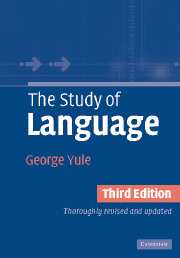Book contents
- Frontmatter
- Contents
- Preface
- The origins of language
- Animals and human language
- The development of writing
- The sounds of language
- The sound patterns of language
- Words and word-formation processes
- Morphology
- Phrases and sentences : grammar
- Syntax
- Semantics
- Pragmatics
- Discourse analysis
- Language and the brain
- First language acquisition
- Second language acquisition/learning
- Gestures and sign languages
- Language history and change
- Language and regional variation
- Language and social variation
- Language and culture
- Appendix: Suggested answers to study questions
- Glossary
- References
- Index
Language history and change
- Frontmatter
- Contents
- Preface
- The origins of language
- Animals and human language
- The development of writing
- The sounds of language
- The sound patterns of language
- Words and word-formation processes
- Morphology
- Phrases and sentences : grammar
- Syntax
- Semantics
- Pragmatics
- Discourse analysis
- Language and the brain
- First language acquisition
- Second language acquisition/learning
- Gestures and sign languages
- Language history and change
- Language and regional variation
- Language and social variation
- Language and culture
- Appendix: Suggested answers to study questions
- Glossary
- References
- Index
Summary
Fæder ure þu þe eart on heofonum,
si þin nama gehalgod.
Tobecume þin rice.
Gewurþe þin willa on eorðan swa swa on heofonum.
Urne gedæghwamlican hlaf syle us to dæg.
And firgyf us ure gyltas,
swa swa we forgyfað urum gyltendum.
And ne gelæd þu us in costnunge,
ac alys us of yfele.
The Lord's Prayer (circa 1000)This barely recognizable version of the Lord's Prayer from about a thousand years ago provides a rather clear indication that the language of the ‘Englisc’ has gone through substantial changes to become the English we use today. Investigating the features of older languages, and the ways in which they developed into modern languages, involves us in the study of language history and change, also known as philology. In the nineteenth century, philology dominated the study of language and one result was the creation of ‘family trees’ to show how languages were related. Before all of that could happen, however, there had to be the ‘discovery’ that a variety of languages spoken in different parts of the world were actually members of the same family.
Family trees
In 1786, a British government official in India called Sir William Jones made the following observation about Sanskrit, the ancient language of Indian law.
The Sanskrit language, whatever be its antiquity, is of a wonderful structure; more perfect than the Greek, more copious than the Latin, and more exquisitely refined than either, yet bearing to both of them a stronger affinity, both in the roots of verbs and in the forms of grammar, than could possibly have been produced by accident.
- Type
- Chapter
- Information
- The Study of Language , pp. 182 - 193Publisher: Cambridge University PressPrint publication year: 2005



